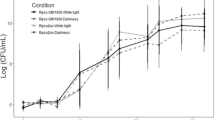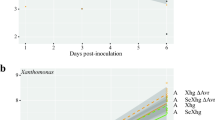Abstract
Bioluminescence (lux) genes from Vibrio fischeri were cloned as a promoter–less gene set into the broad–host–range vector, pUCD4, resulting in the recombinant plasmid pUCD607 that was mobilized into a variety of plant pathogenic and symbiotic bacteria. All bacteria harboring the lux genes under the control of a constitutive promoter in pUCD607 constitutively bioluminesced. Virulence remained unaffected in pathogens carrying pUCD607, and bacterial invasion in host plant tissues was visually followed. The light generated is quantifiable and directly reflects the growth of the pathogen population in host tissue even before the onset of visual symptoms. pUCD607 is relatively stable in bacteria in planta in the absence of selective pressure. Bioluminescence can thus be successfully used to tag genetically engineered bacteria for subsequent monitoring during interactions with plants and in determining their fate in the environment.
This is a preview of subscription content, access via your institution
Access options
Subscribe to this journal
Receive 12 print issues and online access
$209.00 per year
only $17.42 per issue
Buy this article
- Purchase on Springer Link
- Instant access to full article PDF
Prices may be subject to local taxes which are calculated during checkout
Similar content being viewed by others
References
Brown, M.E. 1982. Nitrogen fixation by free-living bacteria associated with plants—fact or fiction? In: Bacteria and plants. Rhodes-Roberts, M. and Skinner, F. A. (eds.) Academic Press, N.Y.
Preece, T.F. and Dickinson, C.H. 1971. Ecology of leaf surface micro-organisms. Academic Press, N.Y.
Vidaver, A.K. 1982. in Phytopathogenic Prokaryotes p. 387–414, Vol. 2. Mount, M. S., Lacy, G. H. (eds.) Academic Press, N.Y.
Misaghi, I.J. 1982. Physiology and Biochemistry of Plant-Pathogen Interactions, Plenum Press, N.Y.
Andrew, J.H. and Kenerley, C.M. 1978. The effects of a pesticide program on non-target epiphytic microbial populations of apple leaves. Can. J. Microbiol. 24:1058–1072.
Sigee, D.C., Smith, V.A. and Hindley, J. 1982. Passage of bacterial DNA into host cells during in vitro transformation of Nicotiana tabacum by Agrobacterium tumefaciens. Microbios 34:113–132.
Engebrecht, J., Nealson, K. and Silverman, M. 1983. Bacterial bioluminescence: isolation and genetic analysis of functions from Vibrio fischeri. Cell 32:773–781.
Engebrecht, J., Simon, M. and Silverman, M. 1985. Measuring gene expression with light. Science 227:1345–1347.
Preece, T.F. 1982. The progression of bacterial disease within plants. In: Bacteria and Plants. Rhodes-Roberts and Skinner, F. A. (eds.) Academic Press, N.Y.
Booth, C.K. and Nealson, K.H. 1975. Light emission by luminous bacteria in the open ocean. Biophys. J. 15:56a.
Miller, J.H. 1972. Experiments in Molecular Genetics. Cold Spring Harbor Laboratory, Cold Spring Harbor, N.Y.
Kado, C.I., Heskett, M.G., and Langley, R.A. 1972. Studies of Agrobacterium tumefaciens: Characterization of strains 1D135 and B6 and analysis of the bacterial chromosome, transfer RNA and ribosomes for tumor inducing ability. Physiol. Plant Pathol. 2:47–57.
Lundquist, R.C., Close, T.J. and Kado C.I. 1984. Genetic complementation of Agrobacterium tumefaciens Ti plasmid mutants in the virulence region. Mol. Gen. Genet. 193:1–7.
Staskawicz, B.J., Dahlbeck, D. and Keen N.T. 1984. Cloned avirulence gene of Pseudononas syringae pv. glycinea determines race-specific incompatibility on Glycine max (L.) Merr. Proc. Natl. Acad. Sci. USA 81:6024–6028.
Boyer, H.W. and Roulland-Dussoix, D. 1969. A complementation analysis of the restriction and modification of DNA in Escherichia coli. J. Mol. Biol. 41:459–472.
Close, T.J., Zaitlin, D. and Kado, C.I. 1984. Design and development of amplifiable broad-host-range cloning vectors: analysis of the vir region of Agrobacterium tumefaciens plasmid pTiC58. Plasmid 12:111–118.
Figurski, D.H. and Helinski, D.R. 1979. Replication of an origin-containing derivative of plasmid RK2 dependent on a plasmid function provided in trans. Proc. Natl. Acad. Sci. USA 76:1648–1652.
Ark, P.A. and Schroth, M.N. 1958. Use of slices of carrot and other fleshy roots to detect crown fall bacteria in soil. Plant Dis. Reptr. 42:1279–1281.
Sutton, J.C. and Williams, P.H. 1970. Relation of xylem plugging to black rot lesion development in cabbage. Can. J. Bot. 48:391–401.
Kelman, A. and Dickey, R.S. 1980. Laboratory Guide for Identification of Plant Pathogenic Bacteria, p. 31–34. Schaad, N. W. (ed.). American Phytopathological Society, St. Paul, Minnesota.
Close, T.J. and Rodriguez, R.L. 1983. Construction and characterization of the chloramphenicol-resistance gene cartridge: A new approach to the transcriptional mapping of extrachromosomal elements. Gene 20:305–316.
Tait, R.C., Lundquist, R.C. and Kado, C.I. 1982. Genetic map of the crown fall suppressive IncW plasmid pSa. Mol. Gen. Genet. 186:10–15.
Bolivar, F., Rodriguez, R., Betlach, M.C. and Boyer, H.W. 1977. Construction and characterization of new cloning vehicles I. Ampicillin-resistant derivatives of the plasmid pMB9. Gene 2:75–93.
Kado, C.I. and Liu, S.-T. 1981. Rapid procedure for detection and isolation of large and small plasmids. J. Bacteriol. 145:1365–1373.
Tait, R.C., Rodriguez, R.L. and West, R.W. 1980. The rapid purification of T4 DNA ligase from a T4lig lysogen. J. Biol. Chem. 255:813–815.
Maniatis, T., Fritsch, E.F. and Sambrook, J. 1982. Molecular Cloning: A Laboratory Manual. Cold Spring Harbor Laboratory, Cold Spring Harbor, N.Y.
Lasky, R.A. 1980. The use of intensifying screens or organic scintillators for visualizing radioactive molecules resolved by gel electrophoresis, p. xxx–xxx. In: Methods in Enzymology, Vol. 65. Grossman, L. and Moldave, K. (eds.). Academic Press N.Y.
Author information
Authors and Affiliations
Rights and permissions
About this article
Cite this article
Shaw, J., Kado, C. Development of a Vibrio Bioluminescence Gene–Set to Monitor Phytopathogenic Bacteria During the Ongoing Disease Process in a Non–Disruptive Manner. Nat Biotechnol 4, 560–564 (1986). https://doi.org/10.1038/nbt0686-560
Received:
Accepted:
Issue Date:
DOI: https://doi.org/10.1038/nbt0686-560
This article is cited by
-
Synthesis of bioluminescent gold nanoparticle–luciferase hybrid systems for technological applications
Photochemical & Photobiological Sciences (2021)
-
Determination of adsorption efficiency based on cation exchange capacity related to red earth, bone meal and pulverised fly ash as ameliorants to lead contaminated soils
International Journal of Environmental Science & Technology (2006)



